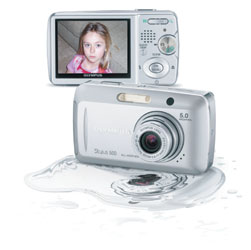 |
|
|||||||
|
Reviews
Olympus Stylus 500 The Stylus digital is doing very well for the company, we hear, and itās easy to see the reasons beyond the cool name: Small size, good performance, weatherproofing, and the kind of design that pleases a mass audience. Weāve reviewed them here several times, and while they always turn in a decent showing and end up on what we internally call our RTF (Recommendable To Friends) list, they always left me a bit cold. The power-on and shutter lag performance was just not up to my personal expectations, and the sliding cover thing turned me off as being a bit too busy and flashy for my taste. Along comes the Stylus 500 and now I have to completely reconsider the Stylus. With a new menu system taken from their best midrange cameras, a huge 215K-pixel 2.5-inch LCD panel, and a sleeker body design overall, they definitely have my attention. This new model is a five-megapixel shooter with specs that youād expect from the thin-zoom category pioneered by Casio, Canon, Sony, and Minolta. Though somewhat beefier than its competition, the Stylus 500 is still a pocket/purse/pack friendly device by any measure. Smooth edges and a lack of protruding controls make it easy, and the automatic lens cover makes it even better. Watch those keys and coins, though, as the LCD is flush mounted with the backplane. A thin neoprene slipcase would be a very good idea ÷ the camera does not come with one, unfortunately. This camera, like its sister Stylii, boast weatherproofing to keep out splashes and rain and, one would assume, dust and dirt. This may well protect the insides from foreign incursion but youāll be sad if your shiny new LCD panel gets all scratched up. As the Olympus website says, taking pictures is fun but showing them off is better. Weāve written many times about the very welcome large LCD trend in thin-zooms ÷ in all digicams, actually. With the gradual untethering of the digital camera from the personal computer, this makes perfect sense. Take a picture, then share it. With a large, crisp, daylight-viewable LCD, you can do it without making anyone squint. This trends also makes possible cameras that lack an optical viewfinder. Purists may quibble, but there really is little need for a traditional finder for 99% of camera users. Simplicity is a good thing, both for makers and users. The Stylus 500 does not have an optical viewfinder and is the better for it.
This camera is not perfect. It uses those pesky xD flash cards instead of SD or CF cards. This type of media can be had in capacities up to 1GB currently ÷ I tested with a Lexar 512MB card that holds a lot of 5MP photos and would absolutely not want to use anything smaller. But xDs cost more than competitive media and are harder to find in a pinch, so I have to give the camera a knock on this count. As I mentioned, the camera is dimensionally-challenged around the midriff ÷ compared to my Casio EX-40 itās positively rotund. Only you can decide how much size matters to you. Lots of people prefer the heft and solid grip of a slightly larger camera. Okay, so the new Stylus looks better than the old one. How does it perform? Iām please to report the 500 is not only better than any previous Stylus digital, it is better than any previous Olympus compact digital camera. Like the competition, Olympus has developed a dedicated image processing chip. Dubbed TruePic Turbo, it does a bang-up job of accelerating startup time, autofocus lock, and shutter response. This performance boost places the 500 right in the pack of thin-zooms. For impatient types like me, this is the most important feature of any camera. Many a model has made a quick trip back to the box for this one reason, but the Stylus 500 is still here on my desk and is likely to remain there for a while. öDavid
MacNeill
|
|||||||
|
|
|||||||
|
©
2004 D.C. Publications, Inc. All Rights Reserved. |
|||||||


 Before
Olympus released the first megapixel consumer digital camera in
1997, their Stylus line of elegant, point-and-shoot film cameras
essentially owned the market. There were plenty of other pocketsize
35mm cameras from every maker, bit none enjoyed the name recognition
of the Stylus models. We always wondered why it took so long for
Olympus to create a Stylus digital camera ÷ the first model was
announced in January 2003. They must have had a good reason, as
they easily could have leveraged the name to sell their digicams
at any point in the game.
Before
Olympus released the first megapixel consumer digital camera in
1997, their Stylus line of elegant, point-and-shoot film cameras
essentially owned the market. There were plenty of other pocketsize
35mm cameras from every maker, bit none enjoyed the name recognition
of the Stylus models. We always wondered why it took so long for
Olympus to create a Stylus digital camera ÷ the first model was
announced in January 2003. They must have had a good reason, as
they easily could have leveraged the name to sell their digicams
at any point in the game.